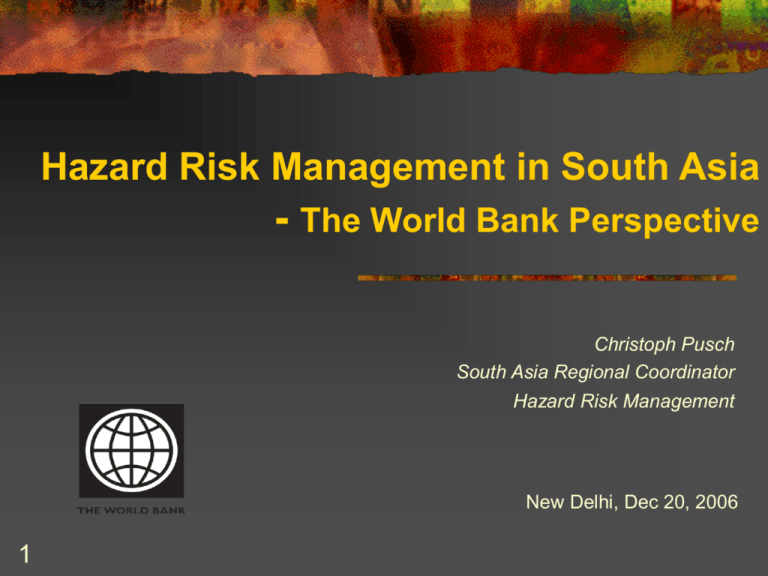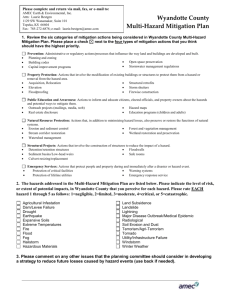MEER Project
advertisement

Hazard Risk Management in South Asia - The World Bank Perspective Christoph Pusch South Asia Regional Coordinator Hazard Risk Management New Delhi, Dec 20, 2006 1 SAR High Vulnerability Area at Risk % 97.1 Population at Risk % 97.7 Nepal 80.2 97.4 Bhutan 31.2 60.8 Pakistan 22.8 49.6 Afghanistan 7.2 46 India 21.9 27.2 Bangladesh Source: WB Natural Disaster Hotspots Study, 2005 2 WB Portfolio – HRM South Asia Region -> more than $12 billion since 1980 Last five years about $2.2 billion $875 million Pakistan earthquake, 2006* $150 million Sri Lanka tsunami, 2005* $465 million India tsunami, 2005* $14 million Maldives tsunami, 2005* $709 million Gujarat earthquake, 2002* * Year of effectiveness 3 Funding limited to reconstruction recovery Demand for mitigation and preparedness is limited Progress of HRM in SAR Efficient responses to major disasters Institutional and legislative arrangements for HRM has improved Strategy development has advanced Main challenges: 4 Mainstreaming HRM in regular development process Translating general concepts and strategies of risk mitigation into specific projects and programs Providing financial incentives and support for risk mitigation projects Developing the concept of risk financing Upgrading implementation capacity Systematic risk assessment and cost benefit considerations for mitigation programs Hazard Risk Management Framework Emergency Preparedness Emergency Response Planning Exercises Public Awareness Communication and Information Management Systems - Technical Emergency Response Capacity Institutional Capacity Building - Risk Assessment - Decentralized Emergency Management System - Community Participation - Legislative Framework - Training, Education and Knowledge Sharing - International Cooperation Risk Mitigation Investments Catastrophe Risk Financing - Warning and Monitoring Systems - Hazard Mapping and Land Use Planning - Code Refinement and Enforcement - Hazard Specific Risk Mitigation - Ex-Ante Funding Arrangements - Catastrophe Insurance Pools - Reserve Funds - Contingent Capital Facility 5 Focus of the World Bank The Bank is interested in financing HRM projects in SAR (national and state level) New vehicle providing co-financing and analytical work GFDRR Preparation of a Hazard Risk Management Strategy 6 Introduction of a comprehensive policy framework focused on the systematic reduction of vulnerability and hazard risks Identification of high priority risk mitigation measures on a country by country basis Formulation of a mid-term action plan with key stakeholder based on a comprehensive consultation process Knowledge Sharing and Dissemination Activities Internal Training / Capacity Building for SAR staff on HRM Expected Outcome 7 Roadmap for vulnerable SAR countries to implement high priority risk mitigation programs and enhancing their capacity to respond to major catastrophic events Comprehensive framework for the systematic treatment of HRM at policy and operational levels for the region Providing the analytical basis for making HRM a standard feature in relevant CASs and PRSPs Exchange of information and know-how between countries on sustainable risk mitigation solutions Stimulating the demand for risk mitigation and prevention interventions Enhancement of the Bank’s internal capacity to respond to catastrophic events and advising clients on the design and management of cross-sector hazard risk mitigation projects and programs





